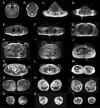Analysis of muscle magnetic resonance imaging of a large cohort of patient with VCP-mediated disease reveals characteristic features useful for diagnosis
- PMID: 37603075
- PMCID: PMC10632218
- DOI: 10.1007/s00415-023-11862-4
Analysis of muscle magnetic resonance imaging of a large cohort of patient with VCP-mediated disease reveals characteristic features useful for diagnosis
Erratum in
-
Correction to: Analysis of muscle magnetic resonance imaging of a large cohort of patient with VCP‑mediated disease reveals characteristic features useful for diagnosis.J Neurol. 2024 Apr;271(4):2147-2148. doi: 10.1007/s00415-023-12178-z. J Neurol. 2024. PMID: 38349561 Free PMC article. No abstract available.
Abstract
Background: The diagnosis of patients with mutations in the VCP gene can be complicated due to their broad phenotypic spectrum including myopathy, motor neuron disease and peripheral neuropathy. Muscle MRI guides the diagnosis in neuromuscular diseases (NMDs); however, comprehensive muscle MRI features for VCP patients have not been reported so far.
Methods: We collected muscle MRIs of 80 of the 255 patients who participated in the "VCP International Study" and reviewed the T1-weighted (T1w) and short tau inversion recovery (STIR) sequences. We identified a series of potential diagnostic MRI based characteristics useful for the diagnosis of VCP disease and validated them in 1089 MRIs from patients with other genetically confirmed NMDs.
Results: Fat replacement of at least one muscle was identified in all symptomatic patients. The most common finding was the existence of patchy areas of fat replacement. Although there was a wide variability of muscles affected, we observed a common pattern characterized by the involvement of periscapular, paraspinal, gluteal and quadriceps muscles. STIR signal was enhanced in 67% of the patients, either in the muscle itself or in the surrounding fascia. We identified 10 diagnostic characteristics based on the pattern identified that allowed us to distinguish VCP disease from other neuromuscular diseases with high accuracy.
Conclusions: Patients with mutations in the VCP gene had common features on muscle MRI that are helpful for diagnosis purposes, including the presence of patchy fat replacement and a prominent involvement of the periscapular, paraspinal, abdominal and thigh muscles.
Keywords: Multisystemic proteinopathy; Muscle MRI; VCP myopathy; Valosin.
© 2023. The Author(s).
Conflict of interest statement
The authors declare no competing interests related to the content of this work.
Figures








Similar articles
-
Novel variants, muscle imaging, and myopathological changes in Chinese patients with VCP-related multisystem proteinopathy.Mol Genet Genomic Med. 2023 Jul;11(7):e2176. doi: 10.1002/mgg3.2176. Epub 2023 Mar 31. Mol Genet Genomic Med. 2023. PMID: 37002192 Free PMC article.
-
VCP myopathy: A family with unusual clinical manifestations.Muscle Nerve. 2019 Mar;59(3):365-369. doi: 10.1002/mus.26389. Epub 2019 Jan 18. Muscle Nerve. 2019. PMID: 30488450
-
VCP-related myopathy: a case series and a review of literature.Acta Myol. 2023 Mar 31;42(1):2-13. doi: 10.36185/2532-1900-244. eCollection 2023. Acta Myol. 2023. PMID: 37091525 Free PMC article. Review.
-
Skeletal Muscle Magnetic Resonance Biomarkers in GNE Myopathy.Neurology. 2021 Feb 2;96(5):e798-e808. doi: 10.1212/WNL.0000000000011231. Epub 2020 Nov 20. Neurology. 2021. PMID: 33219145 Free PMC article.
-
Sex influences clinical phenotype in valosin-containing protein mutations: A case family report and systematic literature review.Clin Neurol Neurosurg. 2023 Sep;232:107875. doi: 10.1016/j.clineuro.2023.107875. Epub 2023 Jul 5. Clin Neurol Neurosurg. 2023. PMID: 37441929
Cited by
-
Muscle Biopsy Findings in Valosin-Containing Protein Multisystem Proteinopathy.Neurol Genet. 2025 Jul 16;11(4):e200265. doi: 10.1212/NXG.0000000000200265. eCollection 2025 Aug. Neurol Genet. 2025. PMID: 40678441 Free PMC article.
-
2024 VCP International Conference: Exploring multi-disciplinary approaches from basic science of valosin containing protein, an AAA+ ATPase protein, to the therapeutic advancement for VCP-associated multisystem proteinopathy.Neurobiol Dis. 2025 Apr;207:106861. doi: 10.1016/j.nbd.2025.106861. Epub 2025 Mar 2. Neurobiol Dis. 2025. PMID: 40037468 Review.
-
Cross-sectional study of patients with VCP multisystem proteinopathy 1 using dual-energy x-ray absorptiometry.Muscle Nerve. 2024 Jun;69(6):699-707. doi: 10.1002/mus.28095. Epub 2024 Mar 29. Muscle Nerve. 2024. PMID: 38551101 Free PMC article.
-
French National Protocol for diagnosis and care of facioscapulohumeral muscular dystrophy (FSHD).J Neurol. 2024 Sep;271(9):5778-5803. doi: 10.1007/s00415-024-12538-3. Epub 2024 Jul 2. J Neurol. 2024. PMID: 38955828 Review.
-
Validity and Reliability of Clinical and Patient-Reported Outcomes in Multisystem Proteinopathy 1.Ann Clin Transl Neurol. 2025 Jul;12(7):1324-1333. doi: 10.1002/acn3.70064. Epub 2025 Apr 28. Ann Clin Transl Neurol. 2025. PMID: 40294152 Free PMC article.
References
-
- Kovach MJ, Waggoner B, Leal SM, et al. Clinical delineation and localization to chromosome 9p13.3-p12 of a unique dominant disorder in four families: hereditary inclusion body myopathy. Paget disease of bone, and frontotemporal dementia. Mol Genet Metab. 2001;74:458–475. doi: 10.1006/mgme.2001.3256. - DOI - PMC - PubMed
MeSH terms
Substances
Grants and funding
LinkOut - more resources
Full Text Sources
Medical
Miscellaneous

